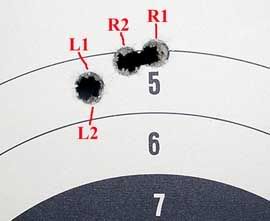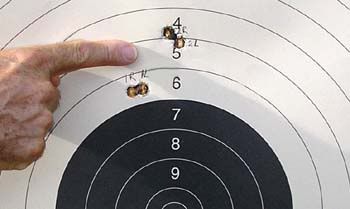| Marrakai |
| (.416 member) |
| 28/08/06 10:31 PM |

|
|
|
The last two double rifles I have added to the meagre collection have one rather undesirable feature in common: they both shoot high! The first addition, a Manton .470 built by John Wilkes, shoots with astounding accuracy, but composite groups at 50 metres are almost 6 inches above the centre of the bead.

The latest acquisition, a Rodda .577/.500 No.2 built by W. & C. Scott and Son, also exhibits uncanny accuracy, but is similarly over 5 inches high at 50 metres.

I had resigned myself to making a taller front sight for the .470, and had conceded to filing-down the shallow vee express sights on the Rodda as part of its extensive refurbishment, but couldn’t help wondering why I had suddenly come face-to-face with this strange phenomenon. Other British doubles in my collection shot perfectly to the sights, a Jeffery .400 in particular showing superb accuracy, and a couple of old hammer-guns with tired first barrels still centering their somewhat lazy groups precisely under the bead. So, before permanently altering metal on these old treasures, my conscience insisted that I should ‘hit the books’ and try to find an explanation.
Well, the standard texts in my library were unfortunately silent on the matter, however I did come across a couple of references to British doubles shooting high in the popular press.
In the 1980s, Ray Ordorica wrote about his 20 years shooting a Churchill .470 double rifle, including the following sighting instructions:
"Place the TOP of the bead where you want the bullets to hit. My .470 is sighted to hit the centre of a 4-inch bull at 50 yards with a 6-o’clock hold."
Too, Ross Seyfried often describes groups shot with vintage Brit doubles as falling "just above the top of the bead."
OK, a few enticing hints there, but then I came across a veritable ‘tirade’ by Sherman Bell who, true to form, had a great deal more to say on the matter in a 2003 Blackpowder Hunting magazine:
"All of these shots were well-centred for windage, but as usual for a British rifle, they landed quite high above the point of aim. This high-shooting tendency is common to many British rifles. I can’t tell you how many times I have removed the original front sight from a valuable double or single-shot rifle, set it aside, and replaced it with a higher sight so the rifle would hit the point of aim. I do not know why the British sighted their rifles so high. I used to think this was the result of shooting ammunition made with components that were not exactly the same as those used in the 19th century. This may indeed account for some of the difference, but not enough to explain a trajectory that is above the point of aim by six inches to a foot, or even more, at 100 yards. It happens with black powder as well as with smokeless. I have read the theory that this high sighting was done purposely, to fool the rifle shooter into thinking the express rifles were more flat-shooting than they actually were. However, most of these rifles came with multiple rear sights for the various ranges, so I fail to see any real or advertising-hype advantage in having a rifle sighted to hit zero at two or three hundred yards with the 100-yard sight leaf. But then, in defence of this theory, when the balance of the rifle is filed to the tolerance of a thin film of smoke, it is difficult to believe that they used a front sight that is a sixteenth of an inch or more too low by mistake. Ah well, another of life’s little mysteries."
So..! What are the collective experiences of the membership here? Has anyone else encountered this ‘high-shooting tendency’ among British sporting rifles? If so, how bad was it?
I intend to proceed as planned, since a rifle which doesn’t shoot to the sights will be a continual source of frustration to me. I have a strong preference for the bullet to land right under the centre of the bead, in fact I consider it crucial for instinctive accuracy when snap-shooting at bolting boars or buff. Nevertheless, I’d be interested in the opinions of others on the permanent modification of sights on vintage British nitro doubles.